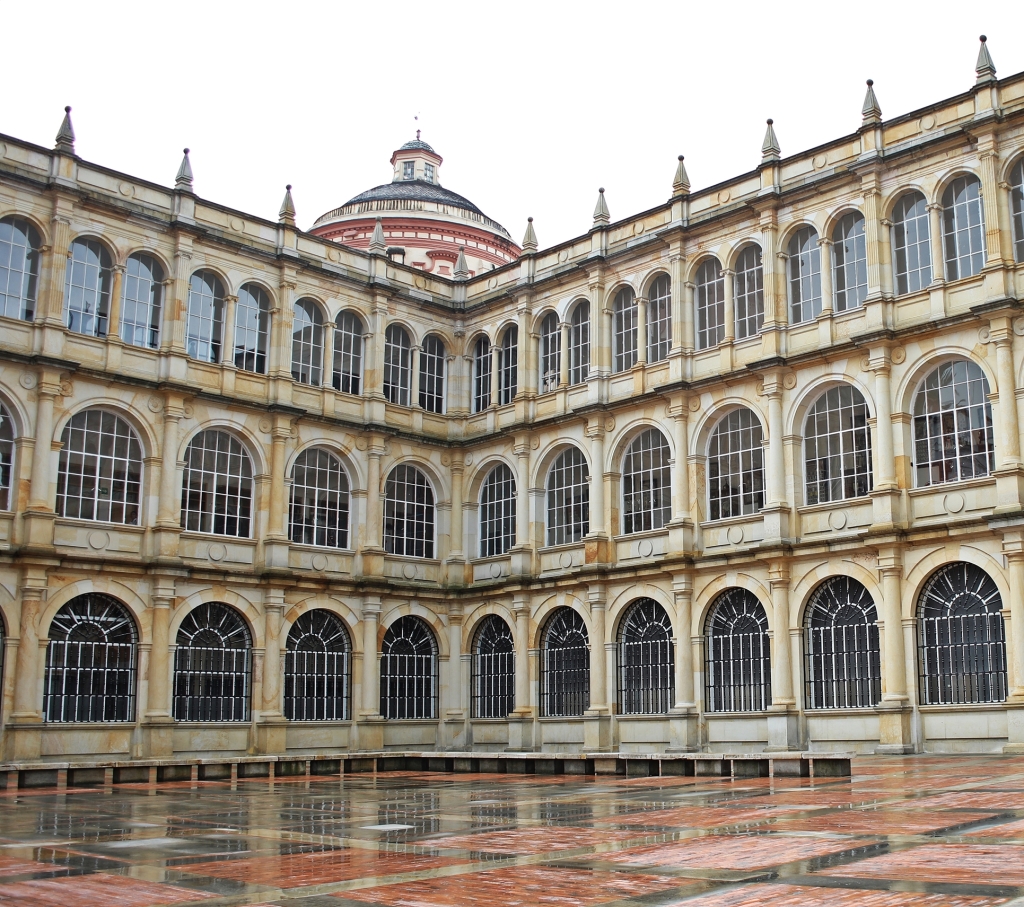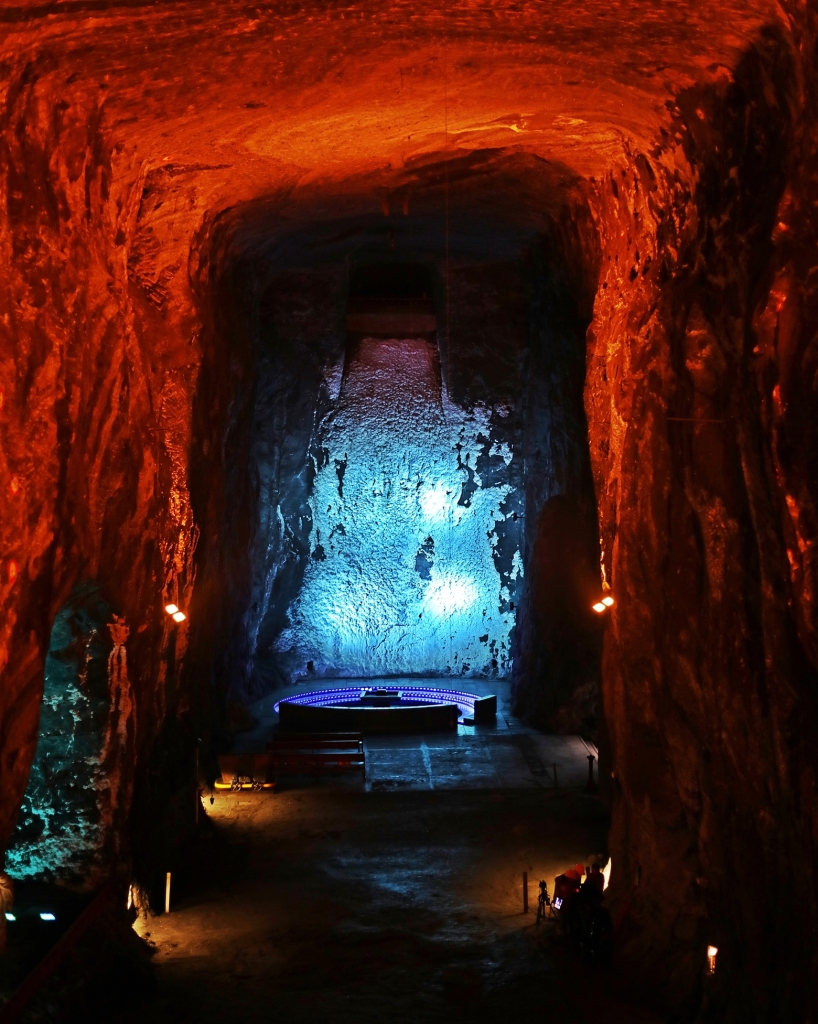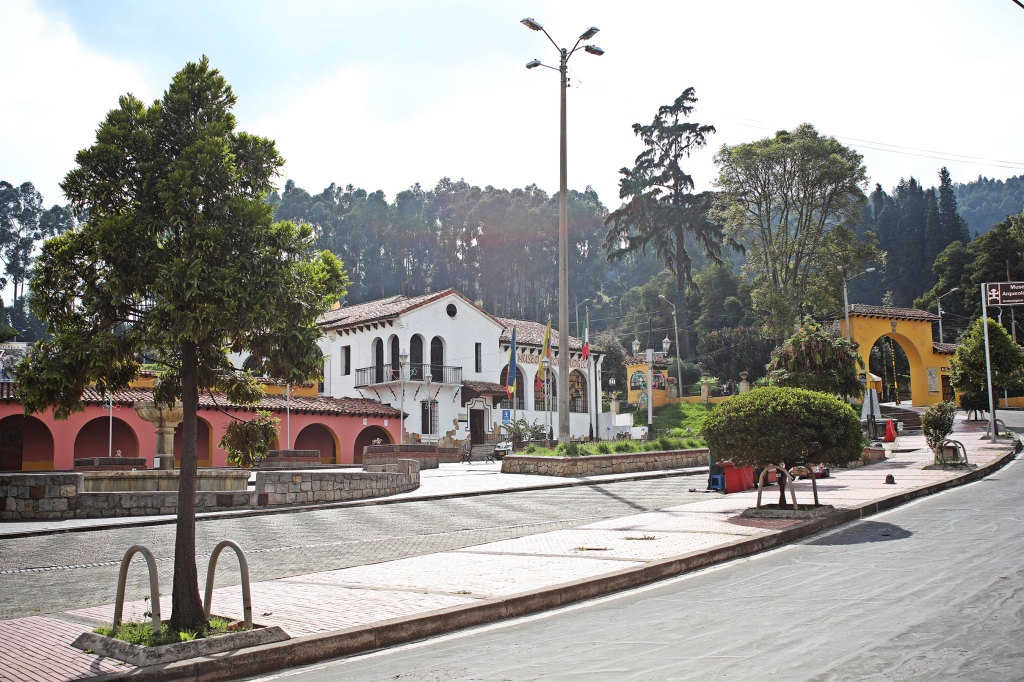Lovely colonial architecture, impressive graffiti art and a fascinating underground cathedral are waiting to be explored in Colombia’s capital city, Bogota.
The capital of Colombia is home to over 7 million people. It is a large busy city, but has a few neighbourhoods with a lot of charm. Unfortunately, on the day we arrived, the people of Colombia were having a one-day peaceful strike to protest many governmental polices. The one-day strike continued for many days and became more violent. At the end of our second day in Bogota, a city-wide curfew was implemented. Because of this, we weren’t able to see much of what Bogota has to offer.

Journalist Park, Bogota 
Espinoza Park, Bogota
La Candalaria
Although La Candalaria is a now a small suburb of Bogota, it was the first neighborhood to be established in mid 1500s. Since Bogota is a hectic, modern city, La Candeleria gives you an idea of how the villagers used to live. Narrow cobblestone streets climb up and down this hilly district and are lined with typical Spanish colonial homes. The homes have whitewashed or painted walls with low terracotta roofs and colourful wooden windows and doors. The lush mountains behind Candelaria make this area picture perfect. One street, Calle del Embudo, is the narrowest and most colourful street in La Candalaria. Graffiti is prolific in Bogota, but on Calle del Embudo, the graffiti is art.

Street in Candalaria, Bogota 
Candalaria, Bogota 
Colonial buildings, Candalaria, Bogota 
Candalaria, Bogota 
Colonial homes, Candalaria, Bogota 
Colonial homes, Candalaria, Bogota 
Calle del Embudo, Candalaria, Bogota 
Graffiti art, Candalaria, Bogota 
Graffiti art, Candalaria, Bogota
We saw many old catholic churches in the area. Some with interesting red and white stripes on the exterior and highly embellished interiors.

Candalaria, Bogota 
Iglesia Nuestra Señora de las Nieves, Bogota 
Colonial church, Candalaria, Bogota
When we were in Bogota, Plaza Bolivar’s buildings were behind security fences and were covered in tarps and to protect them from the protesters. College of St. Bartholomew was the only building in Bolivar Square that wasn’t covered in a tarp. There were many heavily armed police and soldiers in the area. Just as we were getting ready to leave locals warned us that the protesters were getting more aggressive and police were closing access. We had planned on going up to a lookout high above the city but decided it would be better to return to our hotel. The next day we left Bogota.

College of St. Bartholomew, Bolivar Square, Bogota 
Protesters, Bogota
Zipaquira and the Salt Cathedral
Two hours north of Bogota is an important Catholic Cathedral in the city of Zipaquira. The indigenous people have been mining salt in this region for centuries and modern salt mining began in the 1800s. In the 1930s miners carved a small chapel in the walls of the mine so they could pray to the patron saint of miners, Virgin of the Rosary Guasa. They would pray here each day as a safeguard to their dangerous employment. When the mine was exhausted of its minerals, the miners made a plea to allow them to convert it to a church. The mine agreed, but in the 1990s it was deemed unsafe and was permanently closed. A group of local miners and artists from Bogota secured funding to design a new church in a different depleted mine 60m below the previous one. It took a painstaking five years of devotion to transform the former mine to the magnificent house of worship that it is today.
Located 200m below the ground, Catedral de Sal, is actually not a cathedral, but it is an active church. It’s called a cathedral for marketing purposes. After entering the mine you follow a long hallway with a slight downgrade. If you touch the walls you can taste salt on your fingertips. The hallway gives you an idea of the spectacle that is about to come. The arched walls are illuminated with purple lights and in one section the ceiling is filled with bright neon lights. From here, you pass by 14 small chapels each depicting the Stations of Christ on the day of his crucifixion. In Catedral de Sal these stations are represented by artistic renditions of the cross. 14 similar but different crosses are carved into the salt walls of the mine and beautifully illuminated.

Hallway, Catedral de Sal, Colombia 
One of the Stations of Christ, Catedral de Sal, Zipaquera
After passing by these stations you come to a balcony overlooking the cathedral’s main nave. It’s a stunning view. The nave is a long room with a vaulted ceiling and a huge 15m tall cross carved into the front salt wall. The lights make it appear as if its floating. We walked down a flight of stairs, going deeper into the old mine. On either side of the main nave are two others with different carvings of on the front walls. The three together depict Christ’s birth, life and death. On the side is a nativity scene with wooden pews in front. Almost everything in these chapels are carved from salt including the immaculate chandeliers. It’s one of the most interesting churches we’ve seen and in one of the most unusual locations.

Main chapel, Catedral de Sal, Zipaquera 
Nativity scene, Catedral de Sal, Zipaquera 
Nativity scene, Catedral de Sal, Zipaquera 
Salt wall, Catedral de Sal, Zipaquera 
Main chapel, Catedral de Sal, Zipaquera 
Salt cross, Catedral de Sal, Zipaquera
The town of Zipaquira doesn’t see many non-Colombian tourists so we didn’t know what to expect. It surprised us with two nice downtown squares. Parque Principal is a large open square bordered on one side by the lovely Colonial Catedral Diocesana. It’s a brick church with a tall stone bell tower and clock tower. On the other sides of the square are well kept colourful colonial buildings. If you look closely at the cobble stones you’ll notice that the ground is uneven. They paved over mounds around the large palm trees. It was quite an unusual place to walk.
A block away is the smaller Plaza de la Independencia surrounded by old colonial buildings that have been converted into pubs. It’s a much busier square that was filled with younger people out on a Friday night.

Parque Principal, Zipaquera 
Parque Principal, Zipaquira 
Catedral Diocesana, Zipaquira 
Zipaquira 
Plaza de la Independencia, Zipaquira
Catedral de Sal Entry Fee
It is inexpensive at 57,000 COP ($18 USD) and it includes a useful audio guide. There is a market near the exit selling cheesy trinkets, but it’s easy to avoid.
How to get to/from Zipaquira
To/from Bogota – Buses leave for Zipaquira from the Norte Terminal in Bogota. To return to Bogota, catch any bus from Zipaquira terminal that is heading for Bogota Norte. Tell the bus conductor that you need to go to Terminal Salitre. They’ll drop you at a bus stop where you catch a bus named Boyaca which takes 1 – 2 hrs depending on traffic to get to Salitre.
To/From Villa de Leyva– Buses leave from the main bus station in Villa de Leyva hourly and go toward Chiquenquira (1 ½ hrs). From the bus terminal in Chiquinquera catch a minibus to Zipaquira (2 ½ hrs). Return is the reverse.
Coming Next: The Colourful Tatacoa Desert
For extra pictures from Colombia click here. From pictures from our other blogs go to Gallery at monkeystale.ca
To read about more of our adventures go to Destinations.
If you like what you read, please comment or share (with credit) using the links below.

A most enjoyable read. I’d never heard of that church in the salt mine before and it was fascinating to see your photos! Thanks for sharing. Stay well.
LikeLiked by 1 person
Thank you. The Salt Cathedral is a fascinating site and with the lights, it’s quite beautiful. Thanks for giving your comments.
LikeLiked by 1 person
That salt cathedral looks amazing. Too bad you could not see much of Bogota; we did not see much of it either, since it was extremely dangerous at that time. If I remember correctly, the gold museum was certainly a highlight.
LikeLiked by 1 person
The Salt Cathedral was very beautiful and I’m always astounded by what people do for their faith. Unfortunately the Gold Museum was closed, I think because of the protests.
LikeLike
Too bad about the unrest in Bogota. Travelling can be an adventure. Loved the salt church photos. Thanks for sharing. Allan
LikeLiked by 1 person
Thanks Allan, the salt church was very interesting and the lighting makes it so great for pictures. Thanks for reading!
LikeLiked by 1 person
Great blog. You’re more game than I, so it’s wonderful that you do the hard work and I get to enjoy it from a safe place.
LikeLiked by 1 person
Haha, we didn’t expect this adventure, but I guess it is South America! Glad you enjoyed it!
LikeLike
The travelling life can be unpredictable, but seems you rolled with it well!
LikeLiked by 1 person
Yes, some adventures you plan for, others you just have to manage. It was more of an annoyance for us, but it’s their country and they have a right to protest.
LikeLiked by 1 person
I have to say that even though you were disrupted by the riots, Bogotà looked splendid! Don’t know what I’d do had I been there, I suppose my stupidity would lead me to go out and witness in action!
LikeLiked by 1 person
It was tempting to see more of the protests, but when a group of University aged people specifically told us we should leave the area we paid attention.
LikeLiked by 1 person
Amazing! So unfortunate the protests didn’t let you see more of Bogota, but looks like you managed to see more the surroundings. The salt church looks really interesting!
LikeLiked by 1 person
Yes we would have liked another day, but we saw some areas and the rest of Colombia has been amazing. Thanks for reading!
LikeLiked by 1 person
I actually decided to skip Bogotá to spend a few days in Villa de Leyva instead. For whatever reason Bogotá seemed to have a bad rep with travellers when I was there 😂
LikeLiked by 1 person
We weren’t heart broken to leave early but did want to see a few more things. Villa de Leyva was much better. You didn’t miss anything.
LikeLike
Despite the strike/curfew it looks like you still saw a lot. I had no idea that Bogota has such a huge population. The colourful, colonial buildings are beautiful. The story of the salt cathedral is really cool and the nativity scene room is striking. The chandeliers make a real statement…somehow incongruous with the other elements but it works beautifully!
LikeLiked by 1 person
I wish we could have seen more in downtown Bogota especially the gold museum, but the smaller towns are nicer to visit anyway. I certainly didn’t expect chandeliers in a cathedral but they were a nice touch.
LikeLiked by 1 person